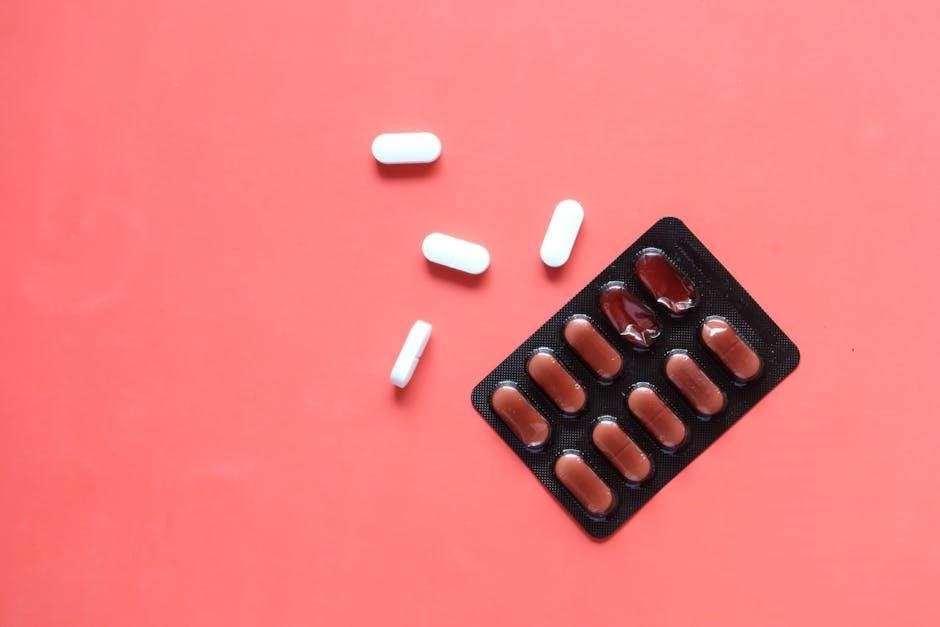The ACLS Drugs Cheat Sheet is a quick reference guide for healthcare professionals, detailing essential medications, their uses, and administration tips during cardiac emergencies, ensuring alignment with current guidelines and best practices for optimal patient outcomes.

Key ACLS Drugs Overview
Essential ACLS drugs include Epinephrine, Vasopressin, Amiodarone, Lidocaine, and Magnesium, each serving critical roles in cardiac arrest management, such as restoring rhythm and maintaining circulation.
2.1. Vasopressors (Epinephrine, Vasopressin)
Vasopressors like Epinephrine and Vasopressin are critical in cardiac arrest management. Epinephrine, dosed at 1 mg IV/IO every 3-5 minutes, enhances heart rate, contractility, and vascular resistance. Vasopressin, given as a one-time 40-unit dose, is an alternative for shock-resistant VF or pulseless VT. Both drugs aim to improve coronary and cerebral perfusion during CPR. Epinephrine is the first-line vasopressor, while Vasopressin may replace the first or second dose of Epinephrine in specific cases. Proper administration and dosing are vital for maximizing effectiveness and minimizing adverse effects, ensuring optimal circulation during cardiac emergencies.
2.2. Anti-arrhythmics (Amiodarone, Lidocaine, etc.)
Anti-arrhythmic drugs, such as Amiodarone and Lidocaine, play a pivotal role in managing arrhythmias during cardiac arrest. Amiodarone is primarily used for VF or pulseless VT, with an initial dose of 150 mg IV and a maximum of 300 mg. Lidocaine, dosed at 1-1.5 mg/kg, is an alternative for patients with severe myocardial ischemia or when Amiodarone is unavailable. These drugs stabilize cardiac rhythms by prolonging action potential duration and reducing ectopic foci. Their administration is critical for halting arrhythmias and restoring a perfusing rhythm, emphasizing their importance in ACLS protocols for achieving successful resuscitation outcomes.
ACLS Drug Pharmacology and Mechanisms
ACLS drugs work by restoring cardiac function through mechanisms like ion channel modulation, receptor stimulation, and electrolyte balance. Their pharmacological effects ensure proper heart rhythm restoration during emergencies.
3.1. Mechanisms of Action
ACLS drugs function through specific mechanisms targeting cardiac physiology. Epinephrine stimulates adrenergic receptors, increasing heart rate and contractility. Amiodarone blocks sodium, potassium, and calcium channels, stabilizing cardiac rhythms. Lidocaine inhibits sodium channels, reducing automaticity in ventricular tissues. Adenosine slows AV node conduction, terminating SVT by disrupting re-entry pathways. Vasopressin increases peripheral resistance and coronary perfusion pressure. These mechanisms ensure restoration of viable cardiac function during emergencies, making them critical in ACLS protocols. Understanding their actions aids in selecting appropriate drugs for specific arrhythmias and cardiac conditions, optimizing treatment efficacy and patient outcomes.
3.2. Drug Interactions and Contraindications
Understanding drug interactions and contraindications is critical in ACLS to avoid adverse effects. Epinephrine may interact with other sympathomimetics, amplifying vasoconstriction. Amiodarone can potentiate effects of beta-blockers and anticoagulants, requiring dose adjustments. Lidocaine interacts with drugs like beta-blockers, increasing toxicity risk. Adenosine is contraindicated in asthma, bradycardia, or AV blocks due to its bronchospastic and vagal effects. Vasopressin should be avoided in conditions like severe hypertension or coronary artery disease. Drug interactions may necessitate dosage adjustments or alternative therapies. Recognizing contraindications ensures safe administration and optimizes patient outcomes during cardiac emergencies.
Drug Administration Tips
Administer drugs during CPR to ensure circulation. After peripheral IV administration, flush with 20 ml IV fluid and elevate the extremity above heart level for 10-20 seconds.
4.1. IV Flush and Extremity Elevation
Proper IV flush and extremity elevation are critical for effective drug administration during ACLS. After administering drugs via peripheral IV, flush with 20 ml of IV fluid to ensure the medication reaches systemic circulation. Elevate the extremity above the level of the heart for 10-20 seconds to enhance venous return and drug distribution. This technique improves absorption and ensures the medication works efficiently. Always follow ACLS guidelines for drug administration to maximize efficacy and minimize complications. Proper flushing and elevation help maintain drug potency and prevent adverse effects, ensuring optimal outcomes in cardiac arrest situations.
4.2. Drug Administration During CPR
Administering drugs during CPR is crucial for ensuring effective circulation and absorption. During cardiac arrest, drugs like epinephrine (1 mg IV/IO every 3-5 minutes) or vasopressin (40 units IV/IO as a one-time substitute) are prioritized. Resume CPR immediately after rhythm checks to maintain perfusion and drug distribution. Epinephrine and vasopressin are key vasopressors used to increase coronary and cerebral perfusion pressure. Always follow ACLS protocols for drug timing and dosing to optimize outcomes. Proper drug administration during CPR ensures medications reach systemic circulation, enhancing their effectiveness in restoring cardiac function. This approach aligns with evidence-based guidelines to improve survival and neurological recovery in cardiac arrest patients.

ACLS Drug Dosages
Standard ACLS drug dosages include: adenosine 6mg rapid IV (12mg if needed), amiodarone 150mg for VF/VT, and atropine 0.5mg.
Ensure doses align with current guidelines for optimal efficacy.
5.1. Adenosine
Adenosine is a first-line treatment for narrow-complex tachycardias, particularly supraventricular tachycardia (SVT). The standard dose is 6mg administered as a rapid intravenous bolus. If no conversion occurs, a second dose of 12mg may be given. It is critical to ensure a defibrillator is readily available during administration. Adenosine has a very short half-life (less than 10 seconds), making it ideal for temporary rhythm control. Contraindications include asthma, bradycardia, and second- or third-degree heart block (unless a functioning pacemaker is present). The dose should be reduced to 3mg in patients on dipyridamole or carbamazepine. Proper administration and monitoring are essential to maximize efficacy and minimize adverse effects.
5.2. Amiodarone
Amiodarone is a critical anti-arrhythmic medication used in ACLS protocols, primarily for treating ventricular fibrillation (VF) and pulseless ventricular tachycardia (VT). The initial dose is 150 mg administered intravenously, with a maximum of 300 mg for recurrent episodes. It is often mixed in a solution of 100 ml of D5W for proper administration. Amiodarone is categorized as a class III anti-arrhythmic, acting by prolonging the cardiac action potential and refractory period. Its broad efficacy makes it a preferred choice in ACLS scenarios. Proper dosing and administration are essential to avoid complications, and it should be used cautiously in patients with underlying hepatic or pulmonary conditions. Always consult ACLS guidelines for specific administration protocols and contraindications.
5.3. Atropine
Atropine is an essential medication in ACLS protocols, primarily used to treat symptomatic bradycardia unresponsive to pacing or other interventions. The standard dose is 0.5 mg administered intravenously, with a maximum of 3 mg per arrest. It works by inhibiting the vagal tone, increasing heart rate, and improving contractility. Atropine is particularly effective in scenarios like pulseless electrical activity (PEA) or asystole when bradycardia is suspected. It should be administered during CPR to ensure optimal circulation. Contraindications include drug-induced bradycardia or conditions where tachycardia is detrimental. Always adhere to ACLS guidelines for proper dosing and administration to maximize patient outcomes and avoid adverse effects.
ACLS Drug Combinations and Synergies
Combining ACLS drugs can enhance therapeutic effects and improve patient outcomes during cardiac emergencies. Common synergies include pairing epinephrine with vasopressin for enhanced vasoconstriction and cardiac output. Amiodarone and lidocaine are often used together to manage refractory ventricular fibrillation or tachycardia, targeting both myocardial stabilization and arrhythmia suppression. Additionally, nitroglycerin and aspirin may be co-administered in acute coronary syndromes to reduce myocardial oxygen demand and prevent further ischemia. These combinations are strategically designed to address multiple pathophysiological processes simultaneously, ensuring comprehensive management of cardiac arrest scenarios. Always consult ACLS guidelines to confirm appropriate pairing and dosing to avoid adverse interactions and maximize efficacy.

Critical Care and Post-Cardiac Arrest Drugs
Critical care and post-cardiac arrest drugs play a vital role in managing patients after resuscitation. Medications like ACE inhibitors and beta-blockers are often used to reduce mortality and improve left ventricular function. Statins and antiplatelet agents are commonly administered to address underlying coronary artery disease. Additionally, anticoagulants may be indicated to prevent further thrombotic events. These drugs are integral to the comprehensive care of post-cardiac arrest patients, aiming to stabilize cardiac function, reduce ischemic risk, and promote recovery. Their use is guided by evidence-based protocols to ensure optimal patient outcomes and minimize complications during the critical post-arrest phase.

ACLS Pharmacological Tools and Resources
ACLS pharmacological tools and resources are essential for effective drug administration. The NHCPS ACLS Pharmacological Tools Guide provides detailed information on medications, dosages, and interactions. The AHA’s CPR and ECC algorithms offer evidence-based recommendations for drug use in cardiac arrest scenarios. Additionally, the ACLS Provider Manual serves as a comprehensive reference, covering drug indications, contraindications, and administration techniques. These resources ensure healthcare professionals can quickly access critical information, optimizing patient care during emergencies. Tools like drug dose calculators and algorithm charts further enhance decision-making. Regular updates to these resources reflect the latest advancements in ACLS pharmacology, ensuring providers stay current with best practices. These tools are indispensable for both training and real-world application in critical care settings.

ACLS Drug Algorithms and Protocols
ACLS drug algorithms and protocols provide structured approaches for managing cardiac arrest and arrhythmias. These guidelines outline the sequence of drug administration, emphasizing timely and appropriate use of medications like epinephrine, vasopressin, and amiodarone. The foundation of ACLS is high-quality Basic Life Support (BLS), with drugs serving as adjuncts to maintain perfusion and restore viable rhythms. Protocols include specific dosing intervals, such as administering epinephrine every 3-5 minutes during CPR, and guidelines for drug administration during ongoing resuscitation efforts. The 2020 Emergency Cardiovascular Care Curriculum and the Megacode Testing Checklist ensure adherence to these protocols, optimizing outcomes in critical care settings. These algorithms are regularly updated to reflect evidence-based practices, ensuring providers deliver care aligned with the latest guidelines.

Pediatric Considerations
Pediatric ACLS requires specialized attention due to differences in drug dosages and physiological responses compared to adults. Weight-based dosing is critical, with calculations tailored to the child’s specific needs. Drugs like epinephrine and amiodarone are used, but doses must be adjusted according to the child’s weight. Neonatal and pediatric resuscitation guidelines emphasize the importance of proper drug administration techniques and monitoring. Specific considerations include age-related differences in drug metabolism and the need for rapid, accurate calculations during emergencies. Resources like the AHA’s ECC algorithms and the NHCPS Pharmacological Tools Guide provide detailed guidance for pediatric care, ensuring safe and effective medication use in young patients.

ACLS Drug Cheat Sheet PDF Resources
Accessing reliable ACLS drug cheat sheets in PDF format is essential for quick reference and exam preparation. Platforms like Docsity offer comprehensive guides, including dosage charts and administration tips. The NHCPS Pharmacological Tools Guide provides detailed drug information, while the AHA’s ECC algorithms ensure evidence-based practices. These resources are designed to simplify complex pharmacological details, making them indispensable for healthcare professionals. Downloading these PDFs allows for offline access, ensuring readiness during emergencies or study sessions. They cover medications, dosages, and administration protocols, serving as a valuable tool for both novices and experienced providers.

Recent Updates and Guidelines in ACLS Pharmacology
Recent updates in ACLS pharmacology emphasize evidence-based practices to enhance patient outcomes. The 2020 AHA guidelines highlight the continued use of epinephrine as the first-line vasopressor in cardiac arrest, with recommendations for standardized dosing. Amiodarone remains the preferred anti-arrhythmic for ventricular fibrillation and pulseless ventricular tachycardia, while lidocaine is reserved for specific cases. The importance of drug administration techniques, such as IV flush and extremity elevation, has been reinforced to ensure optimal medication circulation. These updates reflect a commitment to aligning ACLS practices with the latest research, ensuring that healthcare providers can deliver the most effective care during emergencies.
The ACLS Drugs Cheat Sheet serves as a vital quick-reference guide for healthcare professionals, ensuring adherence to current AHA guidelines and best practices. By organizing essential medication information, dosages, and administration tips, it simplifies decision-making during high-stakes emergencies. Regular updates reflect the latest research and protocols, empowering providers to deliver evidence-based care. This resource is indispensable for ACLS certification and real-world application, helping to improve patient outcomes and streamline resuscitation efforts. Stay informed and prepared with the ACLS Drugs Cheat Sheet, a cornerstone for modern cardiovascular emergency management.
